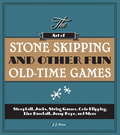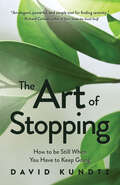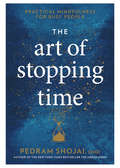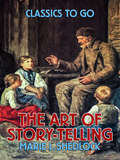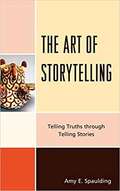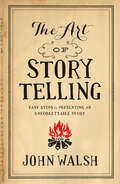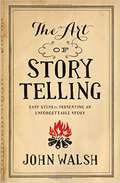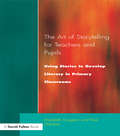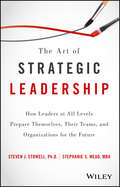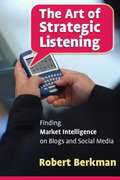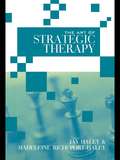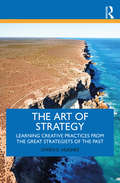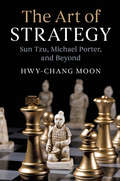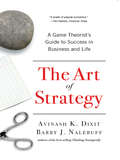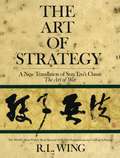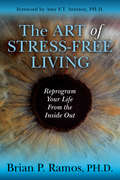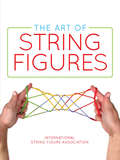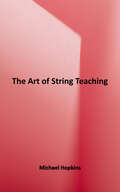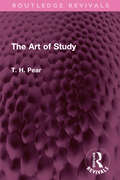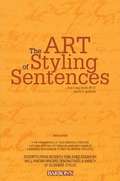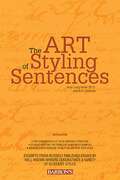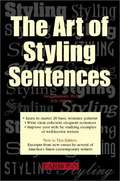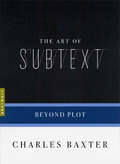- Table View
- List View
The Art of Stone Skipping and Other Fun Old-Time Games
by J. J. FerrarIt's an old-time playtime--nothing electronic, just games that have stood the test of time! They help children build skills like hand-eye coordination, problem solving, and simply learning how to be a good team player and work well with others. But most of all, they're lots of fun. This collection of timeless games guarantees kids a great time--by themselves, with a group of friends, or with their family. And best of all, no batteries are required . . . and very little equipment, too.There's Hopscotch and Dodgeball, Four Square and Stoopball, Horse and One Old Cat (a ball game similar to baseball, but with only one base). All you need is your brain--and occasionally a paper and pen--to play games like Association, the Minister's Cat, and Dumb Crambo (which is similar to Charades, but has a rhyming twist). A rainy day with no pals around would be just right to make Hand Shadows, walk on Can Stilts, or practice Jacks. Don't forget card games like Crazy Eights and Rummy, Crab and Sack Races, and old favorites like Duck, Duck, Goose and Red Rover. And because no parent likes to hear the whine of "Are we there yet?" there's a whole chapter of games for the car!Black-and-white illustrations keep the old-timey feel while getting kids excited to play. Simple instructions explain how many people can play, what you need, the object of the game, and the basic rules. For extra entertainment, there are also lots of fun facts about the history of the games sprinkled throughout. This book is so packed with activities that kids will want to turn off their computers, shut down their PlayStations and Xboxes, and get playing the old-fashioned way!
The Art of Stopping: How to be Still When You Have to Keep Going
by David KundtzCoping Skills for Dealing with the Overwhelming Responsibilities of Life“An elegant, powerful, and simple tool for finding serenity. Just what the world needs right now.” ?Richard Carlson, author of Don't Sweat the Small StuffWe are always on the go. Balancing work, family, friends, and everything in between is a routine of running and never stopping─a cycle that can be tiring. We forget the beauty of the smaller moments and sometimes we forget to stop and use our coping skills.Stopping is a gift to yourself. Knowing when to breathe and regain a clearer vision of yourself and your surroundings helps give you a fresh perspective and an inner balance meant to help you feel in control of the bigger things.Who are you? What are your true priorities? Your responsibilities may have taken over and are preventing you from living to your fullest potential. Dr. Kundtz gives you insight into key questions you should be asking.Stop whatever you’re doing and enjoy the sunrise. Big things can grab your attention but don’t forget to turn around and find the serenity in stillness─the peace in a deep breath, and the happiness in remembering who you are.With this valuable guide learn to:Connect with the spiritual aspects of your lifePractice mindfulness and reduce stressAcknowledge when it becomes too much and take a step backUse proper coping skills to create healthier habitsIf you enjoyed books like The Way of Integrity, Giving Grief Meaning, I Am Invincible, Time Management for Mortals, or The Road Less Traveled, then you’ll love The Art of Stopping.
The Art of Stopping Time: Practical Mindfulness for Busy People
by Pedram ShojaiWe’re all struggling to find time in our lives, but somehow there’s never enough to go around. We’re too tired to think, too wired to focus, less efficient than we want to be, and guilty about not getting enough time with our loved ones. We all know that we feel starved for time, but what are we actually doing about it? Precious little. In The Art of Stopping Time, New York Times bestselling author Pedram Shojai guides us towards success with what he calls Time Prosperity—having the time to accomplish what you want in life without feeling compressed, stressed, overburdened, or hurried. So how do we achieve this Time Prosperity? We learn to Stop Time. To do that, Shojai walks us though a 100-day Gong, which is based on the Chinese practice of designating an amount of time each day to perform a specific task. The ritual helps you become mindful, train your mind, instill new habits, and fundamentally transform your relationship with time. We can find moments of mental awareness while in the shower, eating a snack, listening to podcasts, and even while binge-watching our favorite TV shows.He shares how to use Gongs to reprogram your habits, reduce stress, increase energy, exercise the ancient practice of mindfulness, and become a master of your time. Whether you do one per day, a bunch at a time, or read the whole book in one sitting, practicing the Gongs is a dedicated act of self-love that snaps us out of our daily trance and brings the light of awareness to our consciousness. The more we practice, the more we wake up, and the better off we are.
The Art of Story-Telling (Classics To Go)
by Marie L. ShedlockExcerpt: "Some day we shall have a science of education comparable to the science of medicine; but even when that day arrives the art of education will still remain the inspiration and the guide of all wise teachers. The laws that regulate our physical and mental development will be reduced to order; but the impulses which lead each new generation to play its way into possession of all that is best in life will still have to be interpreted for us by the artists who, with the wisdom of years, have not lost the direct vision of children. Some years ago I heard Miss Shedlock tell stories in England. Her fine sense of literary and dramatic values, her power in sympathetic interpretation, always restrained within the limits of the art she was using, and her understanding of educational values, based on a wide experience of teaching, all marked her as an artist in story-telling. She was equally at home in interpreting the subtle blending of wit and wisdom in Daudet, the folk lore philosophy of Grimm, or the deeper world philosophy and poignant human appeal of Hans Christian Andersen."
The Art Of Storytelling: Telling Truths Through Telling Stories
by Amy E. SpauldingStorytelling is an art, as well as a skill. It allows the listener to take an idea and shape it into something that is relatable on a personal level. In The Art of Storytelling: Telling Truths Through Telling Stories, Amy E. Spaulding enables the reader to learn how to develop this skill, while also discovering the tradition of storytelling. Spaulding covers a wide array of important storytelling elements, from advice on choosing, learning, and presenting the stories to discussions on the importance of storytelling through human history and its continued significance today. This book includes an annotated list of stories, as well as a bibliography of collections and a brief list of recommendations for online sources. Designed for anyone who wants to develop the skill of telling stories, The Art of Storytelling is a resource for drama students, teachers, librarians, and for those learning on their own without a formal class setting.
The Art of Storytelling: Easy Steps to Presenting an Unforgettable Story
by John WalshCan you captivate an audience with your story?Many of us would love to hold the attention of a crowd, a classroom, or just a group of our friends by telling them a great story. We have felt the pressure of a public presentation or the disappointment of telling a story that others ignore. We are ready to be heard, ready to captivate.In The Art of Storytelling, John Walsh takes us through the steps to presenting a compelling story—outlining the strategies that helped him move from stutterer to storyteller. This book will help any person with a story to share by walking you through all aspects of presentation . . . from what to do with your hands as you speak all the way to crafting a killer ending. Whether you&’re telling bedtime stories to your children or Bible stories to a congregation, this book will take your storytelling to a new level.
The Art of Storytelling: Easy Steps to Presenting an Unforgettable Story
by John WalshCan you captivate an audience with your story?Many of us would love to hold the attention of a crowd, a classroom, or just a group of our friends by telling them a great story. We have felt the pressure of a public presentation or the disappointment of telling a story that others ignore. We are ready to be heard, ready to captivate.In The Art of Storytelling, John Walsh takes us through the steps to presenting a compelling story—outlining the strategies that helped him move from stutterer to storyteller. This book will help any person with a story to share by walking you through all aspects of presentation . . . from what to do with your hands as you speak all the way to crafting a killer ending. Whether you&’re telling bedtime stories to your children or Bible stories to a congregation, this book will take your storytelling to a new level.
The Art Of Storytelling: Easy Steps To Presenting An Unforgettable Story
by John D. WalshMany of us would love to hold the attention of a crowd, a classroom, or just a group of our friends by telling them a great story. We have felt the pressure of a public presentation or the disappointment of telling a story that others ignore. We are ready to be heard, ready to captivate. In The Art of Storytelling, John Walsh takes us through the steps to presenting a compelling story—outlining the strategies that helped him move from stutterer to storyteller. This book will help any person with a story to share by walking you through all aspects of presentation . . . from what to do with your hands as you speak all the way to crafting a killer ending. Whether you’re telling bedtime stories to your children or Bible stories to a congregation, this book will take your storytelling to a new level.
The Art of Storytelling for Teachers and Pupils: Using Stories to Develop Literacy in Primary Classrooms
by Elizabeth Grugeon Paul GarderFirst Published in 2000. Routledge is an imprint of Taylor & Francis, an informa company.
The Art of Strategic Leadership: How Leaders at All Levels Prepare Themselves, Their Teams, and Organizations for the Future
by Steven J. Stowell Stephanie S. MeadDevelop the qualities of strategic leadership and become an active contributor to the short- and long-term success of your organization Today's organizations face two daunting challenges: 1. How to create new sources of competitive advantage to sustain long-term growth, and 2. How to engage leaders at every level of the organization so that they are more proactive and forward-looking in their area of responsibility. The Art of Strategic Leadership uses a unique approach to examine what it means to be a strategic leader. Instead of focusing on the skills, behaviors, and tools found in typical books on strategic leadership, the authors shed light on the attributes and qualities necessary to lead strategic change and help transform a business. Strategic leadership is what modern leadership is all about. Organizations expect leaders to anticipate and be proactive more than ever before. In this book, the authors draw on their vast experience working directly with leaders at all levels and use an intriguing narrative to explain this inside-out approach to understanding strategic leadership. The narrative follows the journey of how one manager discovered these critically important qualities. You will experience first-hand how these values and attributes manifest in the lives of realistic leaders; how they orchestrate long-term strategic change needed for the organization to compete and survive and actively shape the future while delivering short-term results. The Art of Strategic Leadership provides the content that will help you informally assess and reflect on your own strategic leadership qualities—those that are strengths and those that indicate areas you need to develop. It will guide you as you incorporate these values and qualities into your own leadership style and become a more effective catalyst for change. This book will help you in the following ways: Develop a more proactive, forward-thinking approach to leadership Approach strategy from both short- and long-term perspectives Adopt the core values and principles of a strategic leader Model the qualities exhibited by powerful leaders Strategic leaders serve as powerful examples to others in the organization. Their qualities and traits spread rapidly to those around them, empowering people at every level to take a more active role in meeting the demands of the future. The Art of Strategic Leadership will help you deepen and broaden your understanding of the core qualities of strategic leadership, leaving you better equipped to lead yourself and your team to a better place and create greater value for customers, owners, and employees.
The Art of Strategic Listening: Finding Market Intelligence through Blogs and Other Social Media
by Robert BerkmanSocial media is the catch-all name for blogs, Web forums, YouTube, MySpace, FaceBook and the other internet-based sites where consumers converse and share content. All of this unsolicited and authentic discussion and opinion can be a great source of marketplace insight for companies. From paying close attention to consumer discussions on blogs and other social media, you can discover what new products or product features consumers would like to see, and stay alert to emerging trends in your industry that could create new opportunities for your company.Robert Berkman, an experienced information specialist with several books to his credit, gives detailed directions for specialized blog searches, setting up RSS feeds, and tracking buzz. He also provides detailed information about vendors who supply blog monitoring services and discusses the pros and cons of using vendors or doing it yourself.For marketers, public relations firms, strategic business analysts, and corporate planners, this book gives you everything you need to know to begin finding market intelligence in social media. You will learn to look for trends, distinguish a trend from a fad, and determine the credibility of the information you uncover. Moreover, Berkman provides you with tips on organizing all the information you find to help you sift through it, locate just the valuable and relevant content, and reduce information overload.
The Art of Strategic Therapy
by Jay Haley Madeleine Richeport-HaleyExperience the art of Jay Haley's strategic therapy as he personally utilizes a variety of techniques in treating depression, violence, and psychosis with couples, children, families and various ethnic groups.Visit www.haley-therapies.com for additional resources by Jay Haley, including live videos of the pioneering therapist in action.
The Art of Strategy: Learning Creative Practices from the Great Strategists of the Past
by Owen E. HughesStrategy is best understood not as a science, but as an art – one of universal applications that transcend situation or historical context. The principles that were successful in war and politics through history can have real and demonstrable applications in business and management. Here, professor of strategy Owen Hughes helps practitioners and students to draw those parallels and to develop a profound and holistic understanding of strategy that will help them plan for, and achieve, success. Describing strategy as an intersection of five facets – purpose, capability, will, terrain and tactics – Hughes draws from colourful and dramatic examples from history, and clearly demonstrates how these tactics might be applied in your own life and work. This book is an ideal strategy text for any practitioner, lecturer or student who tires of familiar strategy frameworks with limited scope.
The Art of Strategy: Sun Tzu, Michael Porter, and Beyond
by Hwy-Chang MoonWhen it comes to strategy, how should we define victory? For centuries, Eastern and Western thinkers have grappled with this question, offering different answers. What can we learn from this difference? In The Art of Strategy, Moon provides a novel and systematic integration of the two dominant frameworks of the East and West: Sun Tzu's military strategy and Michael Porter's business strategy. This unlikely combination of thinking suggests an innovative extension of our understanding and practice of strategy, which will appeal to scholars, students, practitioners and general readers with an interest in strategy. By aligning the perspectives of these two great thinkers, Moon argues that true winning is about maximizing and optimizing overall value for all engaged stakeholders, and this requires a more efficient approach to strategy.
The Art of Strategy: A Game Theorist's Guide to Success in Business and Life
by Barry J. Nalebuff Avinash K. Dixit"I am hard pressed to think of another book that can match the combination of practical insights and reading enjoyment."--Steven Levitt Game theory means rigorous strategic thinking. It's the art of anticipating your opponent's next moves, knowing full well that your rival is trying to do the same thing to you. Though parts of game theory involve simple common sense, much is counterintuitive, and it can only be mastered by developing a new way of seeing the world. Using a diverse array of rich case studies--from pop culture, TV, movies, sports, politics, and history--the authors show how nearly every business and personal interaction has a game-theory component to it. Mastering game theory will make you more successful in business and life, and this lively book is the key to that mastery.
The Art Of Strategy
by R. L. WingMore than 2,500 years ago, Sun Tzu composed his masterpiece The Art of War which has been used by the world's greatest leaders including Napoleon. Here, Wing makes the influential philosophies of the Orient accessible to all seekers of professional achievement and personal excellence.
The Art of Stress-Free Living: Reprogram Your Life From the Inside Out
by Brian P. RamosThe Art of Stress-Free Living helps readers to make simple changes to their lifestyle that allows them to deal with any stressor in a healthy and balanced way which leaves them in the right state of body, mind, and spirit. Stress can feel as if it is affecting who someone truly is and can start to cause problems in one’s relationships and business. The Art of Stress-Free Living is a conscious and powerful approach to health and wellness in which readers discover how to let their best version show up consistently no matter what the circumstance. In The Art of Stress-Free Living, neuroscientist and yoga master Dr. Brian P. Ramos teaches readers how to:Reprogram their DNA naturally to react to stress and life with confidence and powerLearn the secret about stress that changes everything in their life Avoid chronic diseases like diabetes, cancer, mental illness, and neurodegenerative diseases, all linked to a lifetime of uncontrollable stress Deal with stress while still leaving enough in the tank for the activities and people they love Develop practices and habits to use throughout the day – even at work – to reduce long-term stress effects and keep their relationships thriving and intact
The Art of String Figures
by International String Figure AssociationCompiled from issues of String Figure Magazine, simple instructions and easy-to-follow photographs offer step-by-step guides to creating more than two dozen captivating string figures, accompanied by brief accounts of their historical background.
The Art of String Teaching
by Michael HopkinsThe Art of String Teaching a hybrid of written text and high-quality online videos is a comprehensive string pedagogy resource covering everything from the origins and history of the string family to advanced-level string techniques. This one-of-a-kind resource has been divided into two parts. In Part I, Michael Hopkins offers an orientation to string education, outlines his philosophical approach to string education, and provides four chapters on the foundational aspects of string playing for beginning string players. Part 2 focuses on intermediate- and advanced-level instruction, touching on such topics as left-hand shifting, vibrato, bowing techniques, tuning skills, improvisation and composition, and music listening, among others. The two concluding chapters offer insight into the string rehearsal and how to run a successful orchestra program. The appendices contain an abundance of practical and convenient teacher resources, including worksheets, flashcards, string repertoire, scales and arpeggios, a template for method book analysis, and sample assessments and rubrics. QR codes throughout the book link to online video demonstrations of string techniques, and the spiral binding is ideal for playing the included string repertoire from a music stand. This book serves as a useful reference guide for professional orchestra conductors, teachers of group string classes, and private studio teachers. It also addresses the needs of students whose primary instrument is not strings and is suited for use in a string techniques or pedagogy course at the college level.
The Art of Structuring: Bridging the Gap Between Information Systems Research and Practice
by Katrin Bergener Michael Räckers Armin SteinStructuring, or, as it is referred to in the title of this book, the art of structuring, is one of the core elements in the discipline of Information Systems. While the world is becoming increasingly complex, and a growing number of disciplines are evolving to help make it a better place, structure is what is needed in order to understand and combine the various perspectives and approaches involved. Structure is the essential component that allows us to bridge the gaps between these different worlds, and offers a medium for communication and exchange. The contributions in this book build these bridges, which are vital in order to communicate between different worlds of thought and methodology – be it between Information Systems (IS) research and practice, or between IS research and other research disciplines. They describe how structuring can be and should be done so as to foster communication and collaboration. The topics covered reflect various layers of structure that can serve as bridges: models, processes, data, organizations, and technologies. In turn, these aspects are complemented by visionary outlooks on how structure influences the field.
The Art of Study (Routledge Revivals)
by T. H. PearFirst published in 1930, The Art of Study is addressed to all who are old enough and young enough to regard the winning of knowledge as fine art. Like other arts, it can be helped by science. The book discusses reasons for the success and failure of different individuals, not omitting intelligence, stupidity, and laziness. It asks whether the memory can be trained. It contrasts the art forms of the lesson, the lecture, and the talk. It gives suggestions for increasing the student’s concentration upon work, for taking notes, and for using them afterwards. While urging the importance of hard work, it helps the student to discover parts of his tasks in which such effort will be effective.
The Art Of Styling Sentences
by Ann Longknife K. D. SullivanConventions of writing style change in subtle ways with passing years--a fact that prompts the need for periodic revisions of books like this one. The authors review the fundamentals of good sentence structure and then go on to describe twenty basic sentence patterns that encompass virtually every effective way of writing sentences in English. They also draw on passages by current prominent writers, using these examples to show how varying rhythm and sentence patterns can result in elegant writing styles that keep their readers interested. Exercises with answers and explanations appear throughout the text.
Art of Styling Sentences: 20 Patterns For Success
by Ann Longknife K. D. SullivanA Simon & Schuster eBook. Simon & Schuster has a great book for every reader.
The Art of Styling Sentences: 20 Patterns for Success (4th edition)
by Ann Longknife K. D. Sullivan Marie L. WaddellAccepted writing style conventions change very slowly, but they do change. That is all the more reason why this favorite reference book for students, writers, and educators requires periodic updating. In this new edition, the authors review the fundamentals of correct sentence structure, then present twenty basic sentence patterns that encompass virtually every effective way of writing simple, compound, and complex sentences. They give advice on ways yo vary rhythm and sentence patterns to produce a more interesting writing style. Example sentences as well as brief essays by recognized writers are presented and analyzed. This brand-new edition, updated with many new examples of fine writing style, will inspire both students and seasoned writers to make their own essays sing.
The Art of Subtext: Beyond Plot (Art of...)
by Charles BaxterCharles Baxter inaugurates The Art of, a new series on the craft of writing, with the wit and intelligence he brought to his celebrated book Burning Down the House: Essays on Fiction.Fiction writer and essayist Charles Baxter's The Art of Subtext: Beyond Plot discusses and illustrates the hidden subtextual overtones and undertones in fictional works haunted by the unspoken, the suppressed, and the secreted. Using an array of examples from Melville and Dostoyevsky to contemporary writers Paula Fox, Edward P. Jones, and Lorrie Moore, Baxter explains how fiction writers create those visible and invisible details, how what is displayed evokes what is not displayed.The Art of Subtext is part of The Art of series, a new line of books by important authors on the craft of writing, edited by Charles Baxter. Each book examines a singular, but often assumed or neglected, issue facing the contemporary writer of fiction, nonfiction, or poetry. The Art of series means to restore the art of criticism while illuminating the art of writing.
